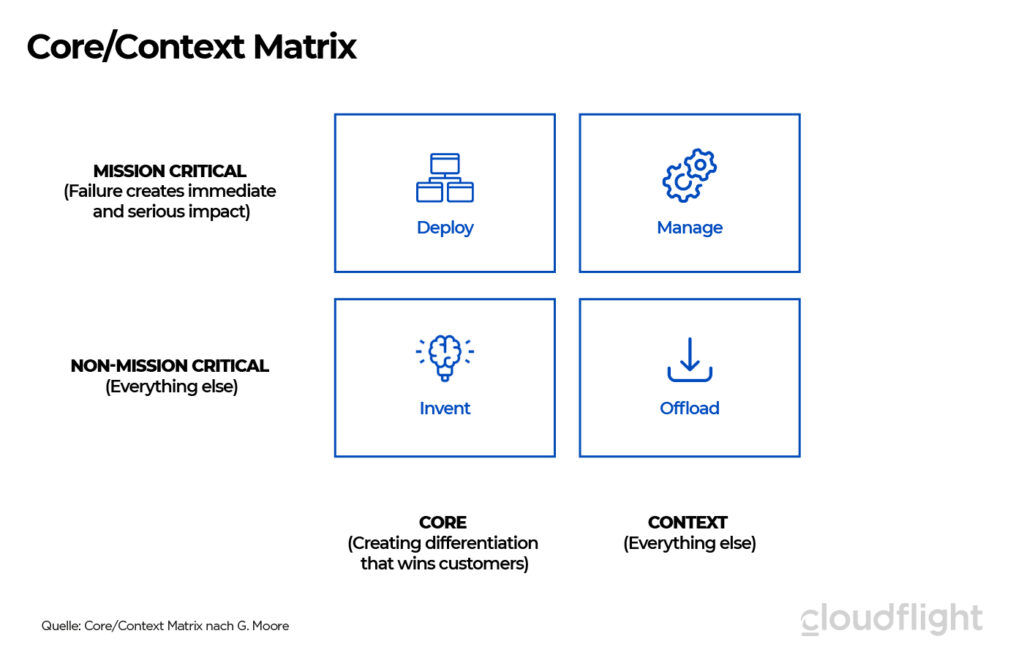It is common knowledge that many companies fail at establishing new digital business models. But what is the reason for their inability to implement digital or software-based value creation?
On one hand, it could be due to a lack of innovation capacity; on the other, it could be due to technical and organizational reasons. Digital value-generation models change ten times faster than physical products and their generation of value. This “slow” development of physical products is also taken into account within the organizations, and the planning horizons in the companies are correspondingly long. To speed up a classic organization tenfold, there must be substantial changes in its processes.
IT and Software departments lead by example here and have adapted to the agile modus operandi time ago. And yet, when it comes to providing fast capabilities and to scaling productively, the traditional model of software development is still very slow.
Cloud-native promises to tackle this problem and address precisely these challenges. It offers state-of-the-art technologies and possibilities and with this the possibility of developing new business models that would have never been possible in the past.
Orchestration of different services
Services orchestrate code, microservices, and containers independently from their origin. This means that it doesn’t matter if they are self-developed, if they come from a worldwide open-source solution, or if they are provided by a hyperscaler. You can combine them into an overall composition and generate previously unattainable customer benefits. For each use case, every company must either write services themselves or turn to a cloud PaaS. Geoffrey Moore’s core/context matrix from “Dealing with Darwin” gives a good indication of the direction one should lean towards for each service:
In this case, the advantage for a few business models is that only the services that contribute to the USP must be developed from scratch, while all the others don’t. That means a company can focus its resources on them, thus consolidating its competitive advantages even more. Furthermore, your business model can be quickly adapted or expanded by integrating new additional microservices and orchestrating them together with the existing elements.
API first
When it comes to integration and interaction between services, there’s no getting around the API-centric approach. The advantages of new digital business models are the countless possibilities to let data flow from both existing and new systems using the API structure, evaluating them accordingly. This provides new insight into customer behavior needs, allowing for a faster reaction to them.
In addition, the API-first approach promotes the platform strategy, in which the collaboration between customers and partners is at the forefront. If an API is made available to its customers, it is easier for them to “dock” to the software or platform and use it to the fullest.
If you expand the platform and ecosystem ideas further, there are further possibilities here to offer your customers significant added value – in some cases even via collaboration with market competitors or with other partnerships.
On top of that, APIs reduce maintenance and scaling costs significantly.
Scalability
By adhering to the cloud-native properties (container, microservices, infrastructure as code, continuous delivery, DevOps & SRE), it is possible to adapt your services very quickly to the requirements.
As a rule, every digital product is too expensive at the beginning, before it generates sales, and if it later grows fast, it is potentially too slow. In this case, container and function computing face this problem through their elasticity.
Here, too, development does not stand still, and IBM recently released its unified Code Engine Service, which combines these two aspects. The IBM Cloud Code Engine is a fully managed, serverless platform. The users only provide their container images, batch jobs, or the source code, and the underlying infrastructure is managed and protected by IBM. This means that container clusters no longer have to be dimensioned, provided, or scaled by the users themselves.
Design Thinking + Agile + Lean = Cloud Native Organization
An additional advantage of cloud-native for new digital business models is that, at the latest, the introduction of the agile culture in a company begins with this. If a company is agile, it can constantly adapt to new challenges quickly.
Cloud-native combines agile culture with the Lean notion that all processes are aimed at the creation of value for the customers: what do they truly want, and how can I offer them the most value?
The goal is to start with an MVP to gather quick feedback from customers and users. Based on this feedback, there are incremental software updates that, time after time, provide more value and meet the customer needs with increasing accuracy.
To keep the timeframe between updates as short as possible, cloud-native relies on the continuous delivery approach. Through it, companies become even more agile and, with their new digital business model, can respond promptly to customer demands and changes in the market.
To develop completely new approaches and ideas, Cloud Native uses design thinking approaches.
Cloud-Native is therefore Design Thinking + Agile + Lean.
Cloud-Native – Technology, paradigm, or culture?
Many regard Cloud Native as a collection of different technologies or a technological platform.
From a strictly technical point of view, at Cloudflight we define cloud-native as an architecture paradigm like mainframe or client-server architecture.
Holistically, we define it as a culture. The reason is that, when there is a cloud-native transformation, it isn’t only the technology of a company that has to change, but also its ways of thinking and working. The starting push usually comes from the upper management level, which initiates a strategy to develop new business models.
So, if you are currently thinking about new business models, you should include the cloud-native approach in your considerations.
We are happy to support you.

